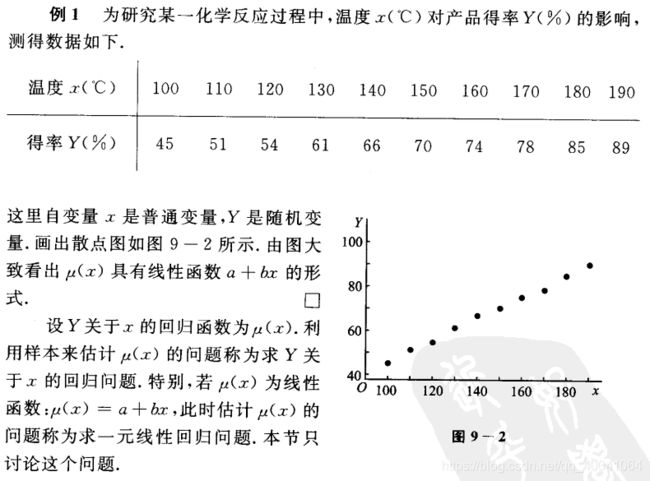Tensorflow2.1.0 基础线性回归
样例为《概率论与数理统计》中线性回归一节中的例子
我们希望通过对该数据进行线性回归,即使用线性模型 ![]() 来拟合上述数据,此处
来拟合上述数据,此处 a 和 b 是待求的参数
接下来,我们使用梯度下降方法来求线性模型中两个参数 a 和 b 的值 3。
回顾机器学习的基础知识,对于多元函数 ![]() 求局部极小值,梯度下降 的过程如下:
求局部极小值,梯度下降 的过程如下:
-
初始化自变量为
 , k=0
, k=0 -
迭代进行下列步骤直到满足收敛条件:
-
求函数
 关于自变量的梯度
关于自变量的梯度 
-
更新自变量:
 。这里
。这里  是学习率(也就是梯度下降一次迈出的 “步子” 大小)
是学习率(也就是梯度下降一次迈出的 “步子” 大小) -
k <- k+1
-
接下来,我们考虑如何使用程序来实现梯度下降方法,求得线性回归的解 ![]() 。
。
NumPy下的线性回归
# 导入相应的模块
import tensorflow as tf
import numpy as np
# 定义数据,并进行归一化操作
X_raw = np.array([100, 110, 120, 130, 140, 150, 160, 170, 180, 190], dtype=np.float32)
y_raw = np.array([45, 51, 54, 61, 66, 70, 74, 78, 85, 89], dtype=np.float32)
x = (X_raw) / 100.
y = (y_raw) / 100.
a, b = 0, 0
num_epoch = 5000
learning_rate = 1e-3
print(learning_rate)
for i in range(num_epoch):
# 预测值
y_pred = a * x + b
# 损失函数为reduce_sum(reduce_squre(y_pred-y))
# 分别计算损失函数对a,b的偏导数
grad_a, grad_b = (y_pred - y).dot(x), (y_pred - y).sum()
# 更新参数
a, b = a-learning_rate*grad_a, b-learning_rate*grad_b
# print(i, 'grad_a:', grad_a, ', grad_b:', grad_b, ', a:', a, ', b:', b)
print(a,b)TensorFLow下的线性回归
import tensorflow as tf
import numpy as np
X_raw = np.array([100, 110, 120, 130, 140, 150, 160, 170, 180, 190], dtype=np.float32)
y_raw = np.array([45, 51, 54, 61, 66, 70, 74, 78, 85, 89], dtype=np.float32)
x = (X_raw) / 20.
y = (y_raw) / 20.
X = tf.constant(x)
Y = tf.constant(y)
a = tf.Variable(initial_value=0.)
b = tf.Variable(initial_value=0.)
variables = [a, b]
num_epoch = 50
# 声明keras模块下的随机梯度优化算法,学习率为0.001
optimizer = tf.keras.optimizers.SGD(learning_rate=1e-3)
for e in range(num_epoch):
with tf.GradientTape() as tape:
y_pred = a*X+b
loss = tf.reduce_mean(tf.square(y_pred-Y))
# 计算损失函数对参数的偏导数
grads = tape.gradient(loss, variables)
# 更新参数
optimizer.apply_gradients(grads_and_vars=zip(grads, variables))
print(a,b)
